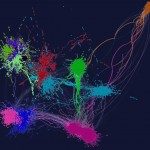Link to Pubmed [PMID] – 9858675
Gene 1998 Nov;223(1-2):33-46
The complete sequence of the yeast Saccharomyces cerevisiae reveals the presence of many new genes, many of which are without homologs in databases. Characterisation of these genes by novel methods includes systematic deletion followed by phenotypic analysis of mutant strains. We have developed a hierarchical strategy for such a functional analysis of genes, in which the primary phenotypic screening is performed on groups of contiguous genes which are then reinvestigated down to the single gene level. This strategy is applied to the whole chromosome XI as part of EUROFAN (the EUROpean Functional ANalysis) program, and we present here our results on a group of 22 genes from this chromosome. This sample is representative of the results that are emerging for the whole chromosome. Out of the 22 genes deleted, three were shown to be essential, and another three genes confer a mutant growth phenotype to cells when deleted. All phenotypes have been complemented. These figures are in accordance with the previously published fraction of lethal and growth-defective deletions of single genes. We have found no synthetic phenotypes resulting from a combination of deleted genes and have always been able to attribute a mutant phenotype to a single gene.

